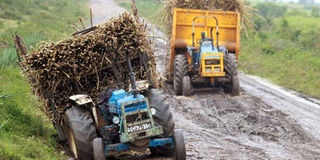There’s silver lining in sugar industry

Tractors carrying sugarcane struggle to pass through bad roads on their way from farms to Muhoroni Sugar Company on September 12, 2016. PHOTO | TONNY OMONDI | NATION MEDIA GROUP
What you need to know:
- Useful diversification initiatives such as the intercropping of cane with soya beans by Nzoia Sugar Company, as a new revenue stream, have been largely ignored by the media.
- Another reporter claimed that Nzoia Sugar had not paid farmers since January last year.
- Bosses of sugar millers must have a tough balance between political acumen and performance in order to see the next day
Cash-strapped, on the deathbed, loan-ridden, brink of collapse, corrupt, archaic, sinking, struggling, and limping are some of the words and phrases that are often used by the media to refer to the sugar industry.
While there is some truth in these allegations, the words also point to an extremely overzealous vanguard stuck to the outdated principle of journalism: When a dog bites a man, it is not news, but when a man bites a dog, it is news! True. Peter Mwaura, the Public Editor of the Nation, in his article published on May 28, 2015 posed: “Positive news versus negative news: what do our readers actually want to read?”
In the same article, Prof Levi Obonyo, the Dean at the School of Communications, Daystar University, wondered how heavy this diet of negative news is to the extent that we are fed on it every day.
Though I hold no brief for Prof Obonyo, he raises a fundamental question about reporting, and if journalism is simply about acting as a conduit or about sacrifices, however occasional, to do good to the greater society.
MILLERS STRUGGLING
It is true that the sugar millers in western Kenya are, indeed, struggling. For example, my friend, Gerald Andae of the Nation Media Group confirms the exuberance by journalists towards negative reporting on the state of the sugar millers.
In June last year, he reported that millers’ inefficiency had been blamed for the sharp fall in production, leading to sugar shortages.
He also reported that almost half of the factories in the region had registered negative growth up to May last year compared to the same period in 2015. How true are these allegations?
Reports such as these are good for the media, but not for the larger society that depends on sugarcane for their livelihood.
Sustained negative reporting has cultivated fear among farmers and potential ones, changing their focus from cane farming to other crops in a futile attempt to improve their economic health.
When will the media set the agenda as well as elicit debate on the plight of the millers away from government and corruption issues?
When will the media focus on the other crucial issues such as irrigation, as a solution to inadequate raw materials for the factories as a result of overreliance on rainfall, which has become irregular in the past 10 or so years?
SILVER LINING
A number of journalists have not bothered to look at the silver lining in cane farming by trying to familiarise themselves with sugar operations! Terms such as TCD (Tons of Cane Delivered), TC: TS ratio, nucleus, and outgrowers are alien to most reporters.
We have also seen reporters who rush to file reports about millers without seeking clarification. Potentially useful diversification initiatives such as the intercropping of cane with soya beans by Nzoia Sugar Company, as a new revenue stream, have been largely ignored by the media.
Recently, the media reported that Nzoia Sugar was on the brink of collapse after acting managing director Michael Kulundu told reporters that the millers were facing challenges of scarcity of the raw material.
Another reporter claimed that Nzoia Sugar had not paid farmers since January last year. Such negligent reporting contributes to the negative energy killing the sugar industry.
TOUGH BALANCE
Bosses of sugar millers must have a tough balance between political acumen and performance in order to see the next day as they manage a larger workforce that is alive to the fact that the factories were started to provide jobs to locals to curb migration to urban areas.
What has been ignored is the environment that companies such as Nzoia, Sony or Chemilil operate. The mushrooming privately owned factories pose a challenges to the old millers.
But the competition is welcome news for farmers. The old millers are heavily regulated, making decision making long and time wasting.
HEAVILY CHALLENGED
The media often depict cane farming as unviable or heavily challenged. Messages to encourage farmers to diversify and intercrop as a safeguard to the ill-economic health in the sugar belt are worth highlighting.
Overreliance on agriculture has been a key contributor to a large number of youth dropping out of school to farm instead of seeking to acquire new knowledge to improve cane yields.
Lack of laws to safeguard raw materials and prevent poaching has not made it any better for millers.
The media must use their massive influence to save the livelihoods of people in the sugarcane belt or they become accomplices in sinking the millers.
It is time they retold the story of the sugar industry to realise the original dream.
Mr Awino is a communications professional in the sugar industry. [email protected]




